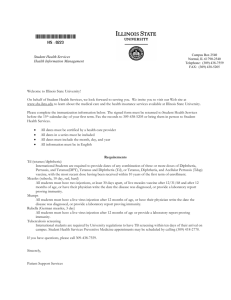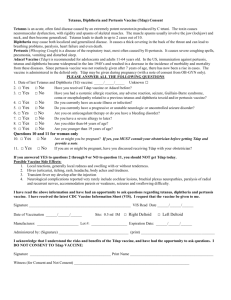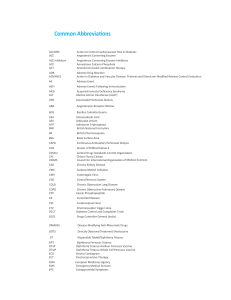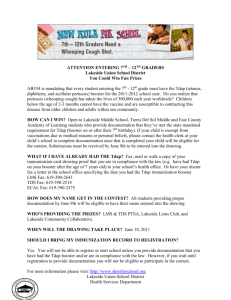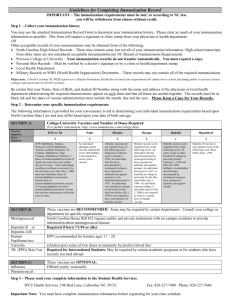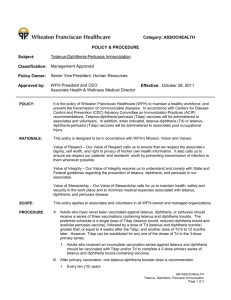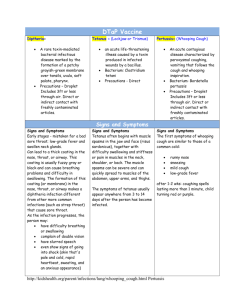Diphtheria, Tetanus, Acellular Pertussis Vaccine (Tdap) (Boostrix
advertisement
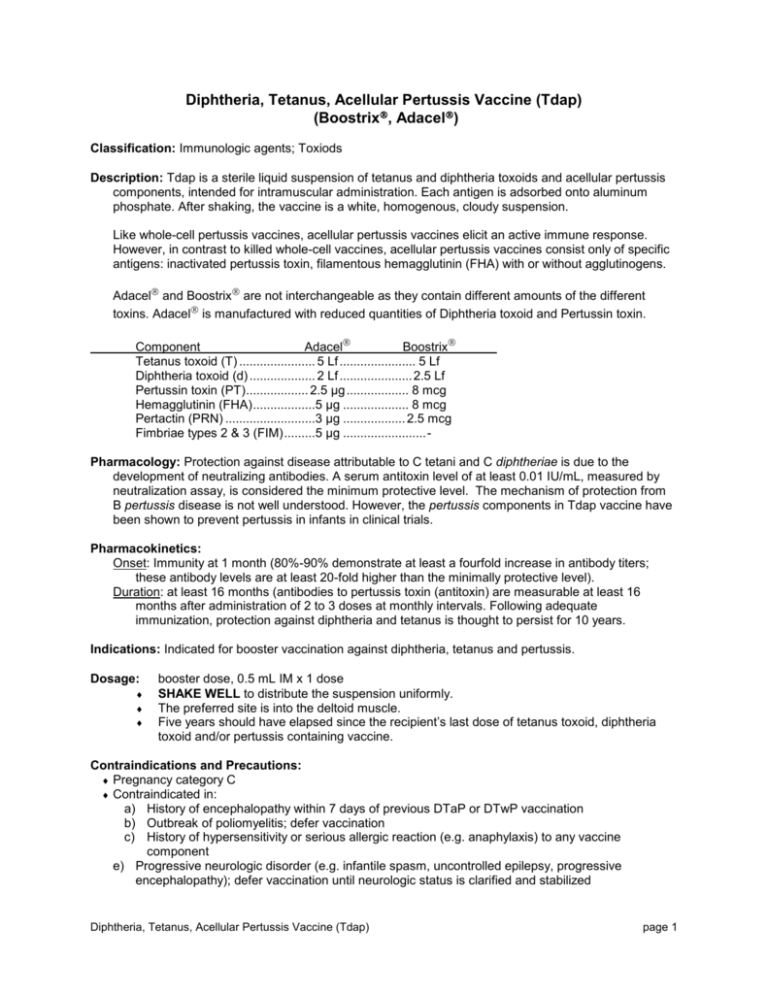
Diphtheria, Tetanus, Acellular Pertussis Vaccine (Tdap) (Boostrix, Adacel) Classification: Immunologic agents; Toxiods Description: Tdap is a sterile liquid suspension of tetanus and diphtheria toxoids and acellular pertussis components, intended for intramuscular administration. Each antigen is adsorbed onto aluminum phosphate. After shaking, the vaccine is a white, homogenous, cloudy suspension. Like whole-cell pertussis vaccines, acellular pertussis vaccines elicit an active immune response. However, in contrast to killed whole-cell vaccines, acellular pertussis vaccines consist only of specific antigens: inactivated pertussis toxin, filamentous hemagglutinin (FHA) with or without agglutinogens. Adacel and Boostrix are not interchangeable as they contain different amounts of the different toxins. Adacel is manufactured with reduced quantities of Diphtheria toxoid and Pertussin toxin. Component Adacel Boostrix Tetanus toxoid (T) ...................... 5 Lf ...................... 5 Lf Diphtheria toxoid (d) ................... 2 Lf ..................... 2.5 Lf Pertussin toxin (PT) .................. 2.5 µg .................. 8 mcg Hemagglutinin (FHA) ..................5 µg ................... 8 mcg Pertactin (PRN) ..........................3 µg .................. 2.5 mcg Fimbriae types 2 & 3 (FIM) .........5 µg ........................ Pharmacology: Protection against disease attributable to C tetani and C diphtheriae is due to the development of neutralizing antibodies. A serum antitoxin level of at least 0.01 IU/mL, measured by neutralization assay, is considered the minimum protective level. The mechanism of protection from B pertussis disease is not well understood. However, the pertussis components in Tdap vaccine have been shown to prevent pertussis in infants in clinical trials. Pharmacokinetics: Onset: Immunity at 1 month (80%-90% demonstrate at least a fourfold increase in antibody titers; these antibody levels are at least 20-fold higher than the minimally protective level). Duration: at least 16 months (antibodies to pertussis toxin (antitoxin) are measurable at least 16 months after administration of 2 to 3 doses at monthly intervals. Following adequate immunization, protection against diphtheria and tetanus is thought to persist for 10 years. Indications: Indicated for booster vaccination against diphtheria, tetanus and pertussis. Dosage: booster dose, 0.5 mL IM x 1 dose SHAKE WELL to distribute the suspension uniformly. The preferred site is into the deltoid muscle. Five years should have elapsed since the recipient’s last dose of tetanus toxoid, diphtheria toxoid and/or pertussis containing vaccine. Contraindications and Precautions: Pregnancy category C Contraindicated in: a) History of encephalopathy within 7 days of previous DTaP or DTwP vaccination b) Outbreak of poliomyelitis; defer vaccination c) History of hypersensitivity or serious allergic reaction (e.g. anaphylaxis) to any vaccine component e) Progressive neurologic disorder (e.g. infantile spasm, uncontrolled epilepsy, progressive encephalopathy); defer vaccination until neurologic status is clarified and stabilized Diphtheria, Tetanus, Acellular Pertussis Vaccine (Tdap) page 1 Use with caution in: a) acute infection or moderate/severe febrile illness; defer vaccination b) central nervous system disorders c) coagulation disorders, including thrombocytopenia, hemophilia, or concomitant anticoagulant therapy; risk of hemorrhage d) collapse or shock-like state (hypotonic-hypo responsive episode) within 48 hours of receipt of whole-cell or acellular DTP vaccine e) convulsions with or without fever occurring within 3 days of receipt of whole-cell or acellular DTP vaccine f) history of Guillain-Barre syndrome within 6 weeks of previous tetanus toxoid-containing vaccination; carefully consider the benefits and possible risks Impaired immune responsiveness; immune responses to vaccine may be suboptimal special care should be taken to prevent injection into a blood vessel temperature of 40.5 degrees C (105 degrees F) or greater within 48 hours of receipt of whole-cell or acellular DTP vaccine not due to another identifiable cause The tip cap and the rubber plunger of the Boostrix needle less profiled syringes contain dry natural latex rubber that may cause allergic reactions in latex sensitive individuals. Interactions: Immunosuppressive therapies, including corticosteroids (used in greater than physiologic doses), may reduce the immune response to vaccines. Adverse Reactions: Dermatologic reactions include erythema, induration, swelling and tenderness at the injection site. Infrequent adverse reactions include: fever (3%-8%), fussiness, anorexia, vomiting and drowsiness. Serious Adverse Effects include: Anaphylaxis, persistent crying (≥3 hours), fever (≥104 degrees F), and seizure. Costs and Monitoring: Boostrix: $ 34.81 for both the profiled syringe and the multi-dose vial Adacel: $ 30.52 Product Identification: Injection Conclusions: Acellular pertussis vaccines were developed in an attempt to reduce the incidence of adverse effects associated with the whole-cell preparation. As compared to diphtheria/tetanus (DT) vaccines, diphtheria/tetanus/pertussis (DTwP) vaccines cause more local and systemic reactions such as anorexia, erythema and induration, fever, fretfulness, hypotonia, pain, swelling, and vomiting. In addition, serious neurotoxic reactions, such as seizures and other encephalopathic syndromes with permanent neurologic sequelae, have been observed with DTP vaccines containing whole-cell Bordetella pertussis. The tetanus toxoid, reduced diphtheria, and acellular pertussis vaccine (Tdap) has primarily replaced the tetanus and diphtheria toxoids vaccine (Td) as routine booster immunization for both adults (19 to 64 years of age) and adolescents (11 to 18 years of age). Recommendations from the Advisory Committee on Immunization Practices The Centers for Disease Control and Prevention, Advisory Committee on Immunization Practices (ACIP) recommends that adults from 19 to 64 years of age be vaccinated with tetanus toxoid, reduced diphtheria, and acellular pertussis (Tdap) vaccine in place of the tetanus and diphtheria toxoids (Td) vaccine. Adults should be vaccinated if they have not had a Td vaccine in at least 10 years. In addition, adults who will have close contact with an infant less than 12 months of age should be vaccinated with Tdap. If possible, vaccination should occur at least 1 month before the beginning of close contact with infants. Intervals shorter than 10 years since the last Td vaccination may be Diphtheria, Tetanus, Acellular Pertussis Vaccine (Tdap) page 2 necessary but a minimum interval of 2 years is recommended to minimize the risk of reactions following vaccination Recommendation: add to formulary References: Tdap monograph. MICROMEDEX(R) Healthcare Series Vol. 129 (2006) Prepared by: Sharon M. Tramonte, Pharm.D. Clinical Pharmacologist San Antonio State School 11 October 2006 Diphtheria, Tetanus, Acellular Pertussis Vaccine (Tdap) page 3
